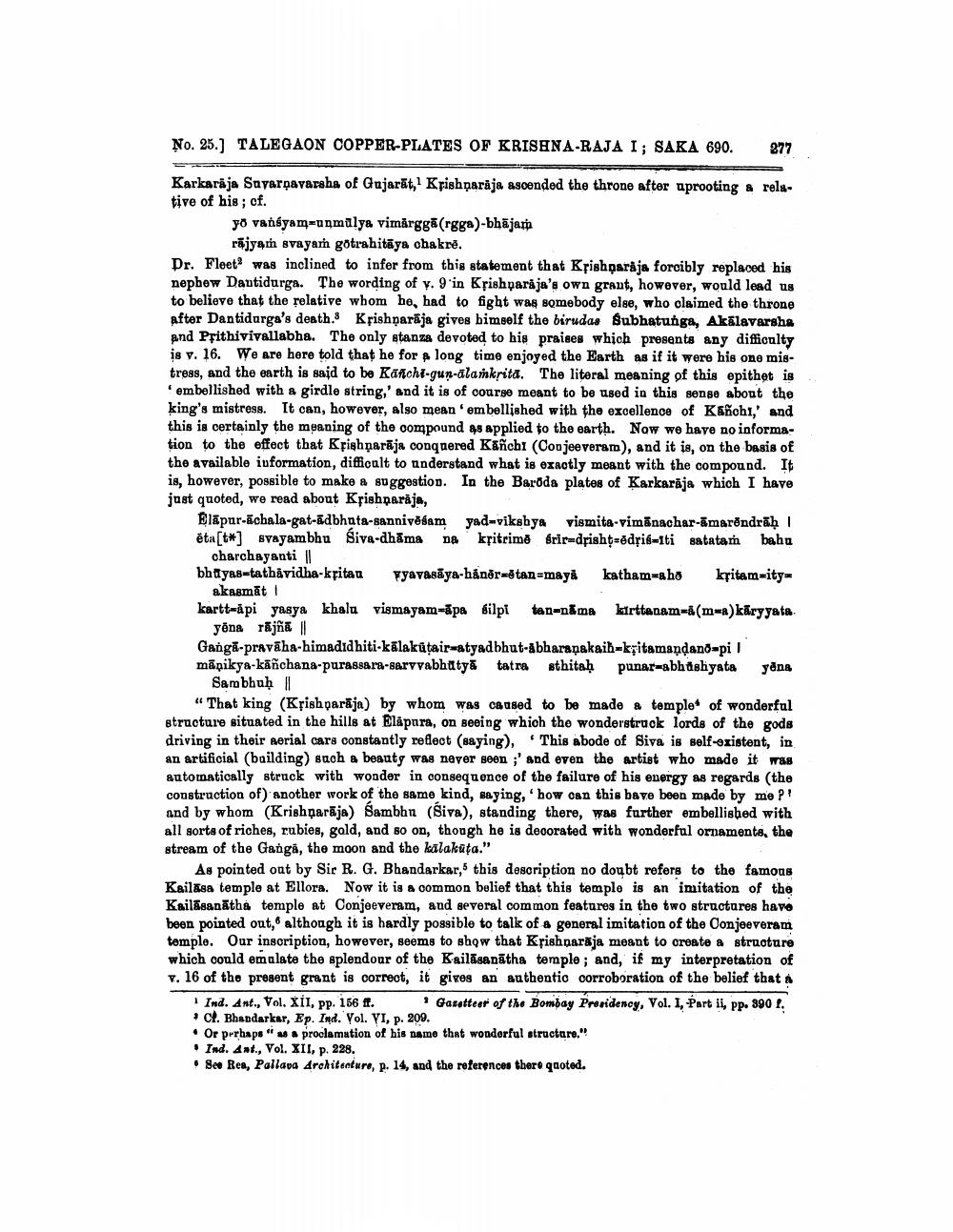________________
No. 25.) TALEGAON COPPER-PLATES OF KRISHNA-RAJA I; SAKA 690.
277
Karkaraja Sayar avarsha of Gujarat, Krishộarāja ascended the throne after aprooting & relative of his; cf.
yo vansyam=unmülya vimärggā (rgga)-bhājam
rajyam svayam gotrahitāya chakrë. Dr. Fleet' was inclined to infer from this statement that Krishparaja forcibly replaced his nephew Dautidurga. The wording of y. 9 in Krishparaja's own grant, however, would lead us to believe that the relative whom he had to fight was somebody else, who claimed the throne After Dantidurga's death. Krishnarāja gives bimself the birudas Subhatunga, Akalavarsha and Pfithivivallabha. The only stanza devoted to his praises which presents any difficulty is v. 16. We are here told that he for a long time enjoyed the Earth as if it were his one mistress, and the earth is said to be Kanchi-gun-alamkrita. The literal meaning of this epithet is * embellished with a girdle string,' and it is of course meant to be used in this songe about the king's mistress. It can, however, also mean embellished with the excellence of Kañohi,' and this is certainly the meaning of the compound & applied to the earth. Now we have no information to the effect that Krishnarāja conqaered Kāñchi (Conjeeveram), and it is, on the basis of the available information, difficult to understand what is exactly meant with the compound. It is, however, possible to make a suggestion. In the Baroda plates of Karkarija which I have just quoted, we read about Krishparaja,
Elapur-Ächala-gat-idbhuta-sannivobam yad=vikshya vismita-vim nachar-Imaröndrāḥ ēta [t] Svayambhu Siva-dhāma na ksitrima Srir-drisht-edrif-iti satatam bahu
charchayanti || bhtiyas-tathavidha-kpitan Fyavasāya-hånõr=ótan=maya katham-aho kritem-ity=
akasmāt! kartt-api yasya khalu vismayam=āpa silpi tan-nima karttanam-(m-a)karyyata
yöna rājña | Ganga-pravāha-himadıdhiti-kālakūtairwatyadbhut-abharaṇakaib-kritamaņdand-pi mānikya-kanchana-purassara-sarvvabhūtā tatra sthitaḥ punar-abhashyata yena
Sambhuḥ0
"That king (Kfishparaja) by whom was caused to be made a temple of wonderful structure situated in the hills at Eläpara, on seeing which the wonderstruck lords of the gods driving in their serial cara constantly reflect (saying), This abode of Siva is self-existent, in an artificial (building) such a beauty was never seen ;' and even the artist who made it was automatically struck with wonder in consequence of the failure of his energy as regards (the construction of) another work of the same kind, saying, 'how can this bave been made by me pi and by whom (Krishnarāja) Sambhn (Siva), standing there, was further embellished with all sorts of riches, rubies, gold, and so on, though he is decorated with wonderful ornaments, the stream of the Ganga, the moon and the kalakuta."
As pointed out by Sir R. G. Bhandarkar, this description no doubt refers to the famous Kailasa temple at Ellora. Now it is a common belief that this temple is an imitation of the Kailasanātha temple at Conjoeveram, and several common features in the two structures havo been pointed out, although it is hardly possible to talk of a general imitation of the Conjoeveram temple. Our inscription, however, seems to show that Krishnaraja meant to create a structure which could emulate the splendour of the Kailāsanātha temple; and, if my interpretation of v. 16 of the present grant is correct, it gives an authentic corroboration of the belief that a
Ind. Ant., Vol. XII, pp. 156 f. Gazetteer of the Bombay Presidency, Vol. I, Part ii, pp. 890 1. . cl. Bhandarkar, Ep. Ind. Yol. VI, p. 209. • Or prrhaps proclamation of his name that wonderful structaro." . Ind. ant., Vol. XII, p. 228. • 8 Ren, Pallava Architecture, p. 14, and the references there qaoted.




